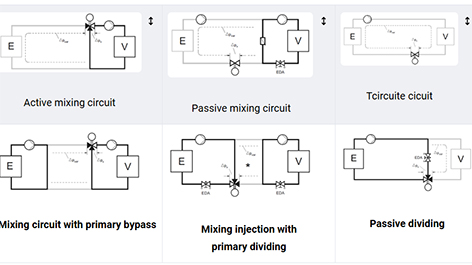Why Differential Pressure Fluctuates in Hydronic Systems
In any hydronic network, pressure drops are not constant. As control valves modulate and branches open or close, the total resistance of the system changes. A fixed-speed pump or poorly tuned control mode will then maintain the original head, even though the system no longer needs it. The result is excessive flow through open circuits, starvation in others and generally unstable behaviour.
Modern systems combine multiple circuits, risers and emitters in one network, often represented as distribution circuits. When these circuits are not hydraulically coordinated, small changes in one part of the system can create large variations in differential pressure elsewhere, especially at part-load.
Aligning Pump Control With System Hydraulics
Pump control determines how the pump reacts when demand changes.
- With constant head, the pump maintains a fixed differential pressure regardless of which valves are open. This often leads to over-pumping during low load.
- With proportional head or more advanced pump control, the pump reduces head as flow rate drops, following the shape of the system curve more closely.
When the pump’s control mode is properly aligned with the hydraulic layout, the differential pressure at the critical points in the system stays within a defined band. This maintains stable operation of control valves and prevents the pump from drifting into inefficient parts of its curve.
Designing Circuits for Stable Δp
Differential pressure control is only effective when the system layout and components are designed for it. Circuits that share a common pump must be balanced so that no branch becomes a shortcut for flow. Balance valves help create comparable resistance between branches, preventing all water from choosing the path of least resistance.
In primary–secondary arrangements or low-loss header concepts, the configuration described in header configuration and related templates defines how Δp is separated between circuits. If this separation is unclear, pumps may “fight” each other or create unstable pressure zones.
A robust design therefore:
- sets realistic design pressure drops for each circuit;
- includes appropriate balancing to distribute pressure losses;
- uses pump control to keep Δp at key locations within a defined range;
- considers part-load operation rather than only full-load conditions.
Benefits of Good Differential Pressure Control
When differential pressure is well managed, the entire system becomes easier to operate:
- Control valves behave predictably, so temperatures and flows respond smoothly.
- Pumps can run at lower heads when loads are low, reducing electricity consumption.
- Flow distribution matches design intent, improving comfort and achievable ΔT.
- Commissioning becomes more straightforward because hydraulic problems appear clearly in the model rather than on site.
Tools that optimise components, support this by assigning appropriate valve Kv/Kvs values, pump heads and balancing settings based on the target pressure regime.
FAQ: Differential Pressure Control in HVAC Systems




